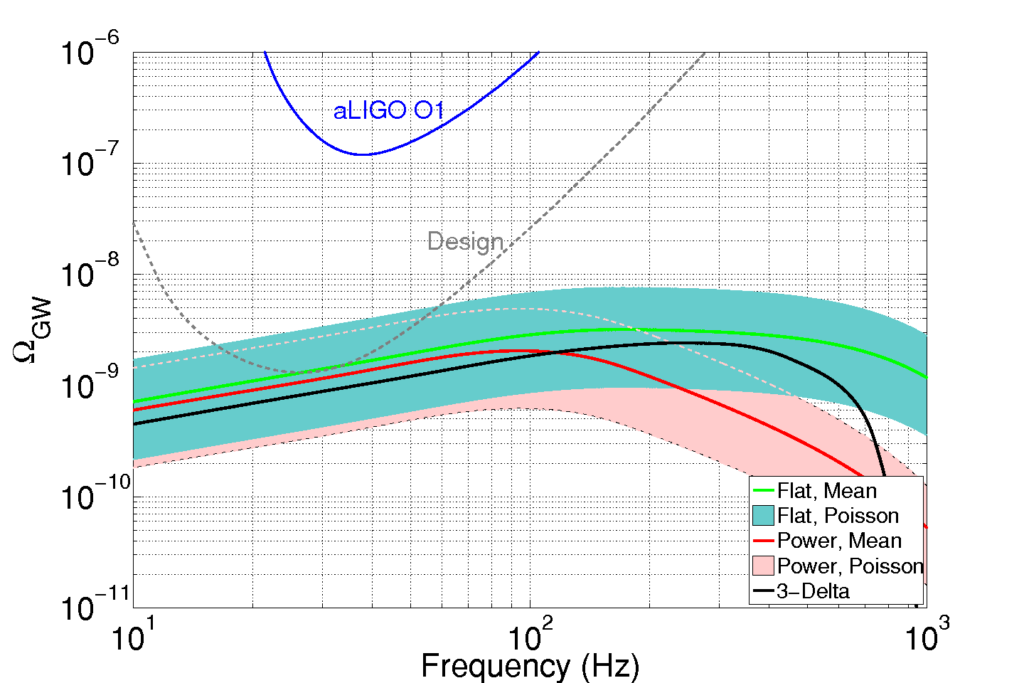The era of gravitational wave physics has begun. In its first observing run, Advanced LIGO ‘heard’ the ringing of two pairs of black holes merging. Based on these detections, the number of nearby black hole mergers is now believed to be quite large, consistent with optimistic expectations before the first observing run took place. This is great news for scientists searching for the stochastic background of gravitational waves, because it means there could be a loud background from black holes to hear!
To understand what a stochastic background is, it is useful to think about listening to the radio. When you turn on a radio, before tuning it to the station you are looking for, sometimes you hear static noise. One of the causes of static is that your radio picks up random (also known as stochastic) vibrations in the environment. This random background is always present, even though we can’t hear it without the help of a radio. In astronomy, one of the most famous examples of a stochastic background is the Cosmic Microwave Background, light from about 380,000 years after the Big Bang, which carries lot of information about the physical conditions in the early Universe.
Similarly, it is thought that there is a stochastic background of gravitational waves. You can ‘listen’ to what the stochastic gravitational wave background might sound like here (keep in mind that this is an analogy–gravitational waves are not sound waves, but we can render them as sound waves to help us understand them). Measuring this background could help us learn about many different phenomena. For example, there are many colliding black hole events that Advanced LIGO is unlikely to hear because they are too far away. Nevertheless, we can hear their collective singing as a stochastic background. There are several other kinds of astrophysical objects that could contribute to this background, like neutron stars and supernovae. It is also thought that ripples from a tiny fraction of a second after the Big Bang can grow into gravitational waves that are detectable as a stochastic background today. Detecting this background would allow us to ‘hear’ further back into cosmic history than we have ever done before. This background could potentially be revealed with future detectors more sensitive than LIGO.
In the first observing, which ran from September 2015 to January 2016, Advanced LIGO searched for the stochastic background of gravitational waves. While no evidence of the background was heard, Advanced LIGO was able to place limits on its loudness (more precisely, on the gravitational wave energy density of the background). The limit on the total energy density is 33 times better than earlier limits obtained from analysis of Initial LIGO and Virgo data–an amazing increase in sensitivity. Achieving this improvement was only possible with the upgrades in the detectors that took them from their initial design to Advanced LIGO. In addition, a significant effort was put into understanding the data to ensure that any background that is detected comes from astrophysical sources, not from the detectors.

We compare observations and model predictions of the stochastic background of gravitational waves across a wide range of frequencies. We can expect the stochastic background to be detectable when its energy density (shown on the vertical axis, as a fraction of the so-called critical density of the Universe) lies above the sensitivity of a given observation. The blue curve labeled ‘aLIGO O1’ shows the sensitivity of Advanced LIGO during the first observing run. The curves marked ‘Initial LIGO-Virgo’ and ‘H1-H2’ show the sensitivity from previous runs of Initial LIGO and Virgo. The dashed gray curve marked “Design” shows the best sensitivity we expect to achieve in future runs of Advanced LIGO and Virgo. There are also other ways to look for the stochastic background, and we have shown the sensitivity of these methods which we label here as ‘CMB’, ‘Pulsar Limit’, ‘Indirect Limits’, and ‘Earth’s Normal Modes’. Finally we present the predicted contribution to the stochastic background from several different models, including binary black holes (BBH), binary neutron stars (BNS) and cosmic inflation. Note that these models lie below the current sensitivity of all methods presented, consistent with the fact that current observations have not detected the stochastic background.
We also studied whether it will be possible for future observing runs of Advanced LIGO and Virgo to detect the background from black hole mergers. We update recent work, taking advantage of the information obtained during the first observing run. By comparing the most likely models for the background from black hole mergers with the projected sensitivity of the advanced detectors, we find that it may be possible for Advanced LIGO and Virgo to detect the background once they have reached their design sensitivity.

This figure shows the sensitivity of gravitational wave detectors to the stochastic background from black hole mergers. The blue-green and red bands at the bottom of the plot shows the energy per unit frequency in several different reasonable models for the predicted stochastic background from black hole mergers. These bands represent our uncertainty in the strength of the background in these models. The bands are based on the number of black hole mergers expected from observations made during Advanced LIGO’s first observing run. The dashed curve shows the projected design sensitivity of Advanced LIGO and Virgo. Since some of the models lie above the sensitivity curve, we conclude that Advanced LIGO and Virgo, at their most sensitive, may be able to hear the background due to the binary black hole mergers.
If you are interested in learning more, also take a look at the directional search for the stochastic background.
Looking forward, gravitational wave detectors will be better able to hear the stochastic background as we listen for longer, as more detectors come online, and as the detectors become more sensitive. Stay tuned!

